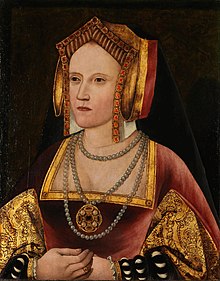Catherine of Aragon
| Catalina of Alcalá de Henares | |
|---|---|
 Portraitc.1520 | |
| Queen consort of England | |
| Tenure | 11 June 1509 – 23 May 1533 |
| Coronation | 24 June 1509 |
| Predecessor | Elizabeth of York(1503) |
| Successor | Anne Boleyn(28 May 1533) |
| Born | 16 December 1485 Archiepiscopal Palace of Alcalá de Henares,Alcalá de Henares,Castile |
| Died | 7 January 1536(aged 50) Kimbolton Castle,England |
| Burial | 29 January 1536 Peterborough Cathedral,Peterborough,England |
| Spouse | |
| Issue | |
| House | Trastámara |
| Father | Ferdinand II of Aragon |
| Mother | Isabella I of Castile |
Catherine of Aragon(Spanish: Catalina) (16 December 1485 – 7 January 1536) was the daughter ofIsabella I of CastileandFerdinand II of Aragon.Catherine was the wife ofArthur, Prince of Walesand later married his brother,Henry VIII.
Early life
[change|change source]When Catherine was three years old, it was decided that she would marryArthur, Prince of Wales.Catherine and Arthur were married on 14 November 1501. They were sent toLudlowCastle inShropshire,to take control of the Council of Wales. Months later, Catherine and Arthur became ill, possibly from a sickness which was sweeping the area at the time. Prince Arthur died on 2 April 1502, leaving after Catherine awidowat the age of 16.
Henry VIIImarried Catherine in 1509, shortly after he became king. She was extremely popular with the people of England. In 1513, when Henry VIII invaded France, she ruled as hisregent.
| Name | Birth | Death | Info |
|---|---|---|---|
| Stillborn twins | December 1502 | December 1502 | |
| Stillborn Daughter | 31 January 1510 | 31 January 1510 | |
| Henry | 1 January 1511 | 23 February 1511 | |
| Louis | 17 September 1513 | 18 September 1513 | |
| Edmund | 29 November 1514 | 2 December 1514 | |
| Mary Tudor of Greenwich | 18 February 1516 | 17 November 1558 | |
| Margret | 10 November 1518 | 11 November 1518 | |
| Ferdinand | 26 January 1522 | 26 January 1522 | |
| Arthur | 4 April 1524 | 4 April 1524 |
Annulment: end of marriage
[change|change source]
Despite Catherine's popularity, she did not produce a surviving son. Her only surviving child was a daughter,Mary I of England.Henry's need for a son caused him to try anddivorcehis wife.
At first, Henry tried to convinceAnne Boleynto be his mistress in 1527. Anne refused, so Henry decided to marry her. Divorce was not allowed in theCatholicfaith. Henry claimed that, as Catherine had been married to his elder brother Arthur, his was an invalid marriage. He quoted a verse inLeviticuswhich states that "a man may not marry his brother's wife and such a union would be without theblessingof God and fruitless ", and used this as his case. It became referred to as the kings" Great Matter "and a special court was held withCardinal Wolseyleading it.
An official fromRomewas brought over and a trial was held. The official stated that he could not come to a conclusion and the case would have to be referred to Rome for thePopeto make a decision. The matter dragged on for quite some time, as the Pope would not agree to anannulment.
Later years
[change|change source]In1532,Anne Boleyn becamepregnantwith the king's child. She was married to Henry on 25January1533so that the baby could be a legitimateheir.Henry's marriage to Catherine of Aragon was finally annulled in the following May by Archbishop Cranmer, thus ending the first of Henry's 6 marriages. The divorce went against the Roman Catholic belief system, so Henry created his own church, theChurch of England.This was the beginnings ofprotestantismin England, with the King as the head of the church instead of the Pope.
Until the end of Catherine's life, Catherine believed that she was the true wife of Henry VIII. Her servants called her their queen, but Henry called her the "Dowager Princess of Wales".
In1535,Catherine was transferred toKimbolton Castleand was not allowed to see her daughter Mary. Henry VIII told her that until they declared Anne their queen, they would be able to see each other. They never did.
Catherine died, most likely ofheart cancer,in January of1536,just five months before theexecutionof Anne Boleyn.
Ancestry
[change|change source]| Ancestors of Catherine of Aragon |
|---|
References
[change|change source]- ↑1.01.1Edwards, John.The Spain of the Catholic Monarchs 1474–1520.Blackwell Publishers Inc, 2000, p. xiii
- ↑2.02.1John II, King of Castilleat theEncyclopædia Britannica
- ↑Burkholder, Suzanne Hiles, "Isabella I of Castile" inEncyclopedia of Latin American History and Culture,vol.3, p. 298. New York: Charles Scribner's Sons 1996.
- ↑4.04.1Ferdinand I, King of Aragonat theEncyclopædia Britannica
- ↑López de Ayala (1780), Tome II,Crónica del rey Enrique II,Año Nono, Cap. II, p. 61.
- ↑Ortega Gato, Esteban (1999)."Los Enríquez, Almirantes de Castilla"(PDF).Publicaciones de la Institución "Tello Téllez de Meneses".70:1–2.ISSN0210-7317.Archived(PDF)from the original on 30 March 2014.Retrieved17 May2018.
- ↑"Mariana de Ayala Córdoba y Toledo".Ducal House of Medinaceli Foundation.Retrieved17 May2018.
- ↑Lee, Sidney,ed. (1896)..Dictionary of National Biography.Vol. 45. London: Smith, Elder & Co. p. 167.
- ↑Gerli, E. Michael; Armistead, Samuel G. (2003).Medieval Iberia.Taylor & Francis. p. 182.ISBN978-0-415-93918-8.Retrieved17 May2018.
